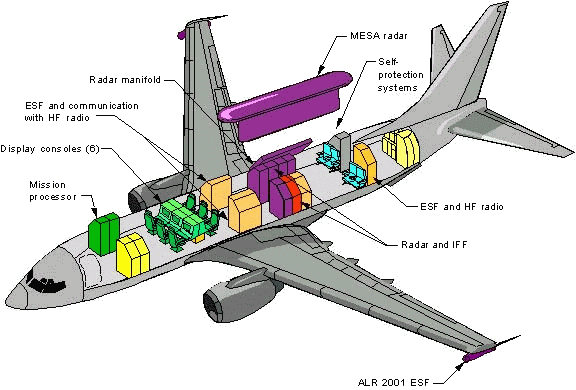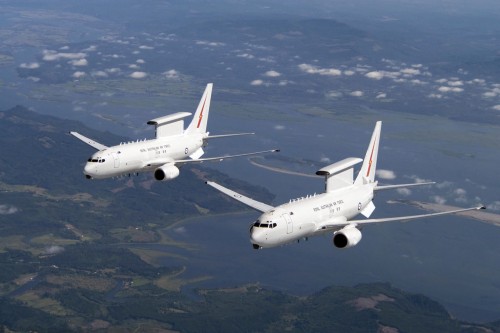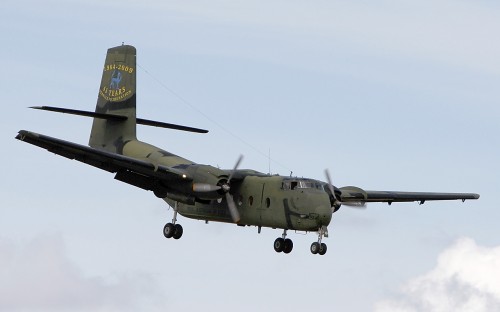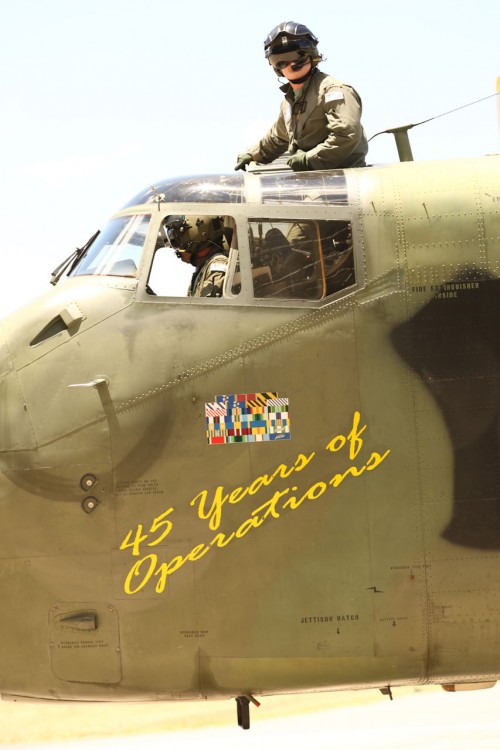Estás usando un navegador obsoleto. No se pueden mostrar estos u otros sitios web correctamente.
Se debe actualizar o usar un navegador alternativo.
Se debe actualizar o usar un navegador alternativo.
el proyecto Wedgetail a resultado ser un fiasco desde el principio... lo que parecia una adaptacion simple a resultado ser un quebradero de cabezas.... y un barril sin fondos con respecto a presupuestos.... un desarrollo larguisimo.. (recuerden que el proyecto data de 1997) y sin resultados satisfactorios a la fecha..... solo lo salva el empecinamiento que han tenido los australianos .. que sino hace rato que estaria muerto...
Delfin
Forista Sancionado o Expulsado
B737 - E-737 AEW&C
Un diagrama para completar...

E-737 AEW&C (AWACS)
FF 21 May 2004
14 Orders (Australia 6, Turkey 4, South Korea 4)
The 737 Airborne Early Warning and Control planes are designed for countries that can't afford or don't need the capability of the much bigger 767 or 707 AWACS. The base plane is essentially a Boeing Business Jet, which has the 737-700 fuselage with the stronger 737-800 wing to support its extra weight and the BBJ aux fuel tanks.
The AEW&C will use a phased-array, Multi-role Electronically Scanned Array (MESA) radar "Top Hat" sensor developed by Northrop Grumman and mounted in a rectangular faring over the rear fuselage. The antenna alone weighs 2950kg and is 10.7m long. However it provides a practical solution for fore and aft coverage while maintaining a low drag profile and allows the system to be installed on the mid-size 737 platform without significant impact on aircraft performance. A 737 airborne early warning plane costs from $150 million to $190 million, compared with about $400 million for the 767 AWACS. The AEW&C carries a mission crew of between 6 and 10 in the forward cabin.
Additional modifications include a new upper lobe section 46 to support the antenna; a new section 41 with a cut-out for an air-to-air refuelling receptacle, two ventral fins to counter balance the antenna and nose, wingtip and tail mounted counter measure systems. The aircraft will also have chaff and flare dispensers and approx 60 antenna and sensor apertures. The IDG's will be uprated to 180kVA. DOW is expected to be just over 50,000Kg.

The first green aircraft arrived at Wichita in December 2002 for structural modifications. Flight testing of the airframe ran from May 2004 until Jul 2005 with the aircraft logging more than 500 flight hours in 245 flights. According to Boeing “The plane performed superbly in terms of its avionics, structure, systems, flight handling characteristics and performance”. This was followed by flight testing of the mission system, including the MESA radar. All appeared to be going well for the project until 2006 when the first of the delays was announced because of “development and integration issues with certain hardware and software components”. Deliveries are expected to begin to Australia in late 2009 and to Turkey not before 2010. The first aircraft are unlikely to reach full operational capability until 2012.
The aircraft will be known as the “Wedgetail” by the RAAF after the Australian Wedgetail Eagle, which according to the Aussies, “Has extremely acute vision, ranges widely in search of prey, protects its territory without compromise and stays aloft for long periods of time.” The Turkish AF will call theirs the “Peace Eagle”, presumably for similar reasons. Boeing are hoping to sell up to 30 AEW&Cs by 2016"
Fuente: http://www.b737.org.uk/737ng.htm
Un diagrama para completar...

E-737 AEW&C (AWACS)
FF 21 May 2004
14 Orders (Australia 6, Turkey 4, South Korea 4)
The 737 Airborne Early Warning and Control planes are designed for countries that can't afford or don't need the capability of the much bigger 767 or 707 AWACS. The base plane is essentially a Boeing Business Jet, which has the 737-700 fuselage with the stronger 737-800 wing to support its extra weight and the BBJ aux fuel tanks.
The AEW&C will use a phased-array, Multi-role Electronically Scanned Array (MESA) radar "Top Hat" sensor developed by Northrop Grumman and mounted in a rectangular faring over the rear fuselage. The antenna alone weighs 2950kg and is 10.7m long. However it provides a practical solution for fore and aft coverage while maintaining a low drag profile and allows the system to be installed on the mid-size 737 platform without significant impact on aircraft performance. A 737 airborne early warning plane costs from $150 million to $190 million, compared with about $400 million for the 767 AWACS. The AEW&C carries a mission crew of between 6 and 10 in the forward cabin.
Additional modifications include a new upper lobe section 46 to support the antenna; a new section 41 with a cut-out for an air-to-air refuelling receptacle, two ventral fins to counter balance the antenna and nose, wingtip and tail mounted counter measure systems. The aircraft will also have chaff and flare dispensers and approx 60 antenna and sensor apertures. The IDG's will be uprated to 180kVA. DOW is expected to be just over 50,000Kg.

The first green aircraft arrived at Wichita in December 2002 for structural modifications. Flight testing of the airframe ran from May 2004 until Jul 2005 with the aircraft logging more than 500 flight hours in 245 flights. According to Boeing “The plane performed superbly in terms of its avionics, structure, systems, flight handling characteristics and performance”. This was followed by flight testing of the mission system, including the MESA radar. All appeared to be going well for the project until 2006 when the first of the delays was announced because of “development and integration issues with certain hardware and software components”. Deliveries are expected to begin to Australia in late 2009 and to Turkey not before 2010. The first aircraft are unlikely to reach full operational capability until 2012.
The aircraft will be known as the “Wedgetail” by the RAAF after the Australian Wedgetail Eagle, which according to the Aussies, “Has extremely acute vision, ranges widely in search of prey, protects its territory without compromise and stays aloft for long periods of time.” The Turkish AF will call theirs the “Peace Eagle”, presumably for similar reasons. Boeing are hoping to sell up to 30 AEW&Cs by 2016"
Fuente: http://www.b737.org.uk/737ng.htm
Perfectirijillo
Colaborador
En estos días la verdad lo extraño a Marito como se cagaba de risa cuando le iba mal a airbus
Y que paso con Marito?, hace mucho que no se le ve
El Ministro de Defensa de Australia, Joel Fitzgibbon, ha confirmado que la Fuerza Aérea retirará sus 13 Caribou a fin de año.
Fitzgibbon ha culpado al anterior gobierno de una mala planificación que impide que se pueda poner en servicio un avión de reemplazo antes del 2013.
La RAAF lamenta la baja de este avión sin encontrar un reemplazo, ya que les es muy útil en operaciones STOL.
Como medio de cubrir el hueco de la baja de los Caribou hasta que se puedan comprar los 14 aviones sustitutos previstos, entrarán en servicio al menos ocho Hawker Pacific King Air .
El Caribou está en servicio con la RAAF desde hace Abril de 1964, habiendo operado en Vietnam, Cachemira, Camboya, Papúa Nueva Guinea, las Islas Salomón y Timor Este.
Fitzgibbon ha culpado al anterior gobierno de una mala planificación que impide que se pueda poner en servicio un avión de reemplazo antes del 2013.
La RAAF lamenta la baja de este avión sin encontrar un reemplazo, ya que les es muy útil en operaciones STOL.
Como medio de cubrir el hueco de la baja de los Caribou hasta que se puedan comprar los 14 aviones sustitutos previstos, entrarán en servicio al menos ocho Hawker Pacific King Air .
El Caribou está en servicio con la RAAF desde hace Abril de 1964, habiendo operado en Vietnam, Cachemira, Camboya, Papúa Nueva Guinea, las Islas Salomón y Timor Este.
boreal
Forista Sancionado o Expulsado
El Ministro de Defensa de Australia, Joel Fitzgibbon, ha confirmado que la Fuerza Aérea retirará sus 13 Caribou a fin de año.
Fitzgibbon ha culpado al anterior gobierno de una mala planificación que impide que se pueda poner en servicio un avión de reemplazo antes del 2013.
La RAAF lamenta la baja de este avión sin encontrar un reemplazo, ya que les es muy útil en operaciones STOL.
Como medio de cubrir el hueco de la baja de los Caribou hasta que se puedan comprar los 14 aviones sustitutos previstos, entrarán en servicio al menos ocho Hawker Pacific King Air .
El Caribou está en servicio con la RAAF desde hace Abril de 1964, habiendo operado en Vietnam, Cachemira, Camboya, Papúa Nueva Guinea, las Islas Salomón y Timor Este.
Pestazo a C-27J buah, ojala me equivoque
Pestazo a C-27J buah, ojala me equivoque
Pues a mí me huele a C-295M que da gusto.
PRIMERA PRUEBA DE LANZAMIENTO DE UN MISIL ASRAAM CON LA RAAF
El grupo del combate aéreo (ACG) de la Real Fuerza Aérea Australiana (RAAF) realizó con éxito un disparo con un misil dirigido infrarrojo ASRAAM (Misil Air-Aire de Corto Alcance Avanzado). La prueba fue realizada por un avión de combate F/A-18, a bajo nivel y a la velocidad típica de combate, contra un blanco situado por detrás del avión a una distancia superior a los 5 kilómetros. El resultado fue un golpe directo en la blanco. La prueba simuló una situación de persecución a bajo nivel por un avión de combate enemigo y demostró con éxito el potencial para una capacidad versátil de autodefensa con el ASRAAM. Esta capacidad es inherente a todas las plataformas que proporcionan información sobre el pre lanzamiento de misiles desde el hombro, tales como el F/A-18, F-35 JSF y Thypoon de Eurofighter. Esta demostración de la capacidad del ASRAAM es un paso importante para la RAAF y aumentando la supervivencia de la flota de F/A-18 del ACG. Es un crédito al equipo de RAAF-MBDA-DSTO que trabajó en conjunto para entregar esta capacidad de punta a la flota de F/A-18 de la RAAF. El misil ASRAAM fue incorporado al servicio con la RAAF en julio de 2004. Para proporcionar niveles únicos en apoyo de servicio, las instalaciones para un mantenimiento más profundo y el software de apoyo fueron establecidas en Adelaida, inyectado algo más de 20 millones de dólares australianos en la economía durante 6 años. La planta del software de apoyo, situada en la Defence Science & Technology Organisation en Edimburgo (SA), permite que Australia modifique el software del misil ASRAAM en respuesta a los requisitos específicos de la fuerza australiana de defensa. La planta de mantenimiento establecida por BAE Systems en el parque de Edimburgo proporciona la capacidad al país para apoyar la línea frontal de su equipo. Incorporando servicio con la real fuerza aérea y desplegado en los aviones Tornado, Thypoon, y pronto en los F-35 JSF, el programa del ASRAAM ha proporcionado una oportunidad única para el intercambio de información entre las fuerzas aéreas respectivas, los departamentos gubernamentales y las organizaciones científicas.
de espejo aeronautico
El grupo del combate aéreo (ACG) de la Real Fuerza Aérea Australiana (RAAF) realizó con éxito un disparo con un misil dirigido infrarrojo ASRAAM (Misil Air-Aire de Corto Alcance Avanzado). La prueba fue realizada por un avión de combate F/A-18, a bajo nivel y a la velocidad típica de combate, contra un blanco situado por detrás del avión a una distancia superior a los 5 kilómetros. El resultado fue un golpe directo en la blanco. La prueba simuló una situación de persecución a bajo nivel por un avión de combate enemigo y demostró con éxito el potencial para una capacidad versátil de autodefensa con el ASRAAM. Esta capacidad es inherente a todas las plataformas que proporcionan información sobre el pre lanzamiento de misiles desde el hombro, tales como el F/A-18, F-35 JSF y Thypoon de Eurofighter. Esta demostración de la capacidad del ASRAAM es un paso importante para la RAAF y aumentando la supervivencia de la flota de F/A-18 del ACG. Es un crédito al equipo de RAAF-MBDA-DSTO que trabajó en conjunto para entregar esta capacidad de punta a la flota de F/A-18 de la RAAF. El misil ASRAAM fue incorporado al servicio con la RAAF en julio de 2004. Para proporcionar niveles únicos en apoyo de servicio, las instalaciones para un mantenimiento más profundo y el software de apoyo fueron establecidas en Adelaida, inyectado algo más de 20 millones de dólares australianos en la economía durante 6 años. La planta del software de apoyo, situada en la Defence Science & Technology Organisation en Edimburgo (SA), permite que Australia modifique el software del misil ASRAAM en respuesta a los requisitos específicos de la fuerza australiana de defensa. La planta de mantenimiento establecida por BAE Systems en el parque de Edimburgo proporciona la capacidad al país para apoyar la línea frontal de su equipo. Incorporando servicio con la real fuerza aérea y desplegado en los aviones Tornado, Thypoon, y pronto en los F-35 JSF, el programa del ASRAAM ha proporcionado una oportunidad única para el intercambio de información entre las fuerzas aéreas respectivas, los departamentos gubernamentales y las organizaciones científicas.
de espejo aeronautico
Lo mismo digo yo, dudo que ese sea el casco, sino chau HUD. cosa que no creo que sea así, el casco del Rhino es el JHMCS.El mismo que el del F-35?
Aprovecho para preguntar, se ensamblan en Australia? o es la fábrica de Boeing esa?
paulo
Forista Sancionado o Expulsado
Australia empieza a recibir los ‘Wedgetail'

La Defence Materiel Organisation de Australia comenzó a recibir las dos primeras aeronaves AEW&C “Wedgetail” de la Boeing.
La entrega de las primeras aeronaves va a permitir el entrenamiento y la familiarização de las tripulaciones, mientras a Boeing completa el programa de tests y actividades de aceptación.
Cuando totalmente operacionales, los “Wedgetail” van a mejorar en mucho la capacidad de vigilancia, defensa aérea, apoyo a la fuerzas navales y coordinación de operaciones conjuntas.
A Boeing planea los tests iniciales de aceptación de las dos primeras aeronaves en el según semestre de 2010, cuando ellas pasarán a pertenecer al Commonwealth.
El Commonwealth eventualmente quiere adquirir 6 “Wedgetail” al coste de 4 mil millones de dólares australianos.
FUENTE / FOTO: Boeing

La Defence Materiel Organisation de Australia comenzó a recibir las dos primeras aeronaves AEW&C “Wedgetail” de la Boeing.
La entrega de las primeras aeronaves va a permitir el entrenamiento y la familiarização de las tripulaciones, mientras a Boeing completa el programa de tests y actividades de aceptación.
Cuando totalmente operacionales, los “Wedgetail” van a mejorar en mucho la capacidad de vigilancia, defensa aérea, apoyo a la fuerzas navales y coordinación de operaciones conjuntas.
A Boeing planea los tests iniciales de aceptación de las dos primeras aeronaves en el según semestre de 2010, cuando ellas pasarán a pertenecer al Commonwealth.
El Commonwealth eventualmente quiere adquirir 6 “Wedgetail” al coste de 4 mil millones de dólares australianos.
FUENTE / FOTO: Boeing
paulo
Forista Sancionado o Expulsado
RAAF se despide del DHC–4 ‘Caribou'

Real Fuerza Aérea Australiana da adiós al su más viejo avión
En ceremonia del aeropuerto de Canberra el día 27.11.09, la RAAF regaló el Australian War Memorial con la aeronave Caribou A4–140. Australia fue una de las primeras operadoras del Caribou (recibiendo 29 aeronaves de 1964 a 1971) y la que operó el avión por más tiempo.
Famoso por su habilidad de despegar y aterrizar corto en pistas no-preparadas, el Caribou substituyó el Dakota en el 38th Squadron.
El avión deja una impresionante hoja de servicios en tiempos de guerra y de paz y quedará en la añoranza de los entusiastas.
FUENTE: Ministerio de la Defensa de Australia

Que descance el querrero..... estoy pensando en los Bufalos de la FAB...
....Saudosos salutos.....

Real Fuerza Aérea Australiana da adiós al su más viejo avión
En ceremonia del aeropuerto de Canberra el día 27.11.09, la RAAF regaló el Australian War Memorial con la aeronave Caribou A4–140. Australia fue una de las primeras operadoras del Caribou (recibiendo 29 aeronaves de 1964 a 1971) y la que operó el avión por más tiempo.
Famoso por su habilidad de despegar y aterrizar corto en pistas no-preparadas, el Caribou substituyó el Dakota en el 38th Squadron.
El avión deja una impresionante hoja de servicios en tiempos de guerra y de paz y quedará en la añoranza de los entusiastas.
FUENTE: Ministerio de la Defensa de Australia

Que descance el querrero..... estoy pensando en los Bufalos de la FAB...
....Saudosos salutos.....
Austrália considera SU-34 para defesa naval
http://www.areamilitar.net/noticias/noticias.aspx?nrnot=485
http://www.areamilitar.net/noticias/noticias.aspx?nrnot=485
Temas similares
- Respuestas
- 5
- Visitas
- 1K
- Respuestas
- 5
- Visitas
- 847
- Respuestas
- 23
- Visitas
- 3K





